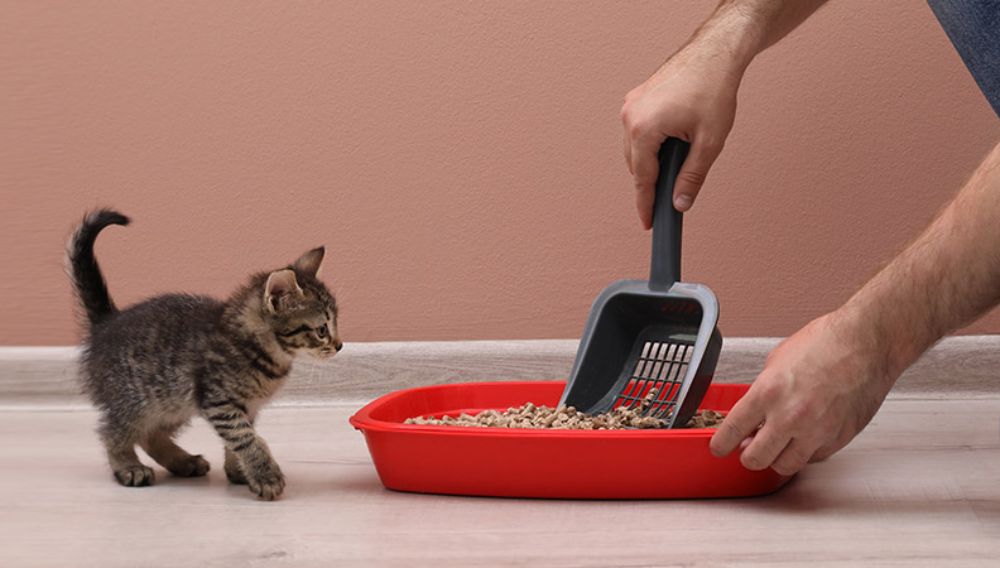
Congratulations on welcoming a delightful new kitten into your home! While a new addition to your family is exciting, the idea of kitten litter training can feel daunting.
Fear not, new cat owners! With the right tools for the job, a little encouragement and plenty of patience, you'll be nudging your feline friend towards mastering toilet time in no time. Here's a list of our top kitten litter box training tips.
Set Up the Perfect Potty Palace
Just like us humans, kittens have preferences when it comes to the bathroom. That's why it's so important to create a litter tray haven that encourages your furball to use it with confidence.
Firstly, let's think of the box itself. Cats need something spacious, with enough room to comfortably turn around and dig. Open trays are generally preferred over covered boxes, especially for younger kittens who might feel claustrophobic and want to know what's going on around them.
Next, location. Would you feel comfortable using a toilet in one of the busiest corners of the home? The best spots are tucked out of the way with an unobstructed view of the area (cats love to watch out for possible ambush!). Your furry friend probably won’t feel comfortable doing their business close to where they have dinner, so keep them away from feeding stations, too.
As a starting point, you should kit out your home with one box per cat, plus one extra. This provides options and reduces competition in multi-cat households. Many want a space of their own and won’t use a tray that other cats in the home use.
Kitten Comfort is King
When it comes to litter training kittens, you want to ensure their complete comfort and satisfaction. To achieve this, consider the type of litter you use, its depth, and know how to maintain cleanliness and hygiene.
Kittens have delicate paws, so avoid harsh, dusty litters. While clumping litter is a popular choice, many cat owners opt for softer, natural litter made from wood pellets or recycled paper. Have a little experiment to see what your kitten prefers.
For litter depth, a shallow layer of around two to three inches is ideal. This allows kittens to easily dig and do their business without feeling overwhelmed.
No one wants to use a dirty toilet, including your kitten! When it comes to cleaning the litter box. scoop waste daily and change the litter at least once a week.
Encourage Your Cat to Use the Litter Tray
Lots of newly adopted kittens start gravitating towards their tray and get on with it from the moment they arrive. However, you may need to encourage your cat and show your kitten the litter tray.
Once you welcome them into their new home, take your cat over to the box and let them scratch around. They might catch on to what it is immediately – or they might jump right out of it. If it’s the latter and 'little accidents' are happening throughout the day, it’s time to be more proactive. Using an enzymatic cleaner for accidents outside the box will help remove lingering odours on carpets and other surfaces.
There are certain times when your cat’s more likely to need the loo: first thing in the morning, post-nap, and after a meal or playtime. These are the times you should physically carry them over to the tray, before giving them a little privacy.
When your kitten does use the box, shower them with praise! A petting session or a small treat can go a long way in creating a positive association with the litter tray.
Accidents Happen, Don't Panic!
If you do come across a surprise on the carpet, how should you react?
Shouting and scolding won’t get you far. For one thing, you’ve probably only noticed it after the event. Your cat won't be able to make the connection between what’s on the carpet, the cross human in front of them – and what they have to do with any of it!
Stern words can be counterproductive. The most likely outcome is a scared and confused kitty, which definitely isn't what you need when trying to teach a kitten to use a litter box.
So, keep your cool. Hang on in there with the coaxing and carrying them over to the litter tray. Eventually, they will get it!
How Long Does It Take to Litter Train a Kitten?
Each feline is unique with varying individual needs. However, if you get the foundations right, alongside patience and positive reinforcement, your kitten should complete their litter tray training within four to six weeks.
But what if they just don't get it? You’ve coaxed. You’ve carried. You’ve played around with different locations for your tray. You’ve even tried different types of boxes and litters. Still nothing.
If this goes on for longer than usual, it might be time for some input from your vet. Various medical issues, such as urinary tract conditions or intestinal parasites, could potentially hinder your kitty's ability to hold it in or make it painful to ‘go’.
The quicker these issues are fixed, the sooner they can get down to business!
Protect Your New Kitten With Everypaw
We don't just provide tips for litter training kittens. Our Everypaw cat insurance, which includes kitten insurance, comes with 24/7 unlimited access to vets and vet nurses that can help with your four-legged friend's health, care, nutrition and behaviour.
Take out one of our purr-fect policies to receive a free hamper and manage your cover online in our dedicated Pet Portal. With 98% of claims paid within five days*, you can rest assured your kitty will be well looked after.
Remember, kittens and litter training don't have to be a stressful combination. Take the time to enjoy the cuddles and the joy of raising a healthy, happy new furry friend!
*Based on Everypaw claims data from May 2023 to June 2024